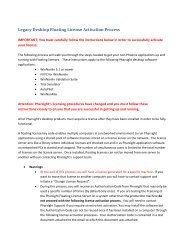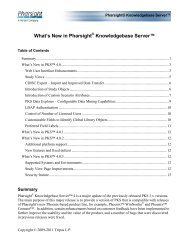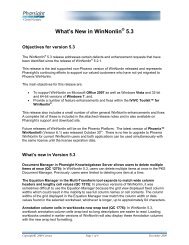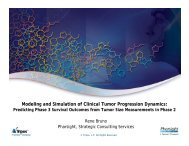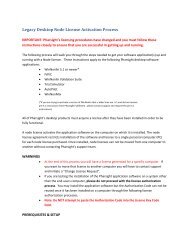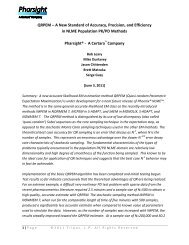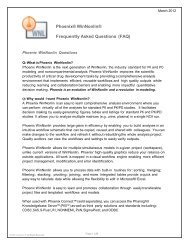PHX WNL QA_13April20.. - Pharsight
PHX WNL QA_13April20.. - Pharsight
PHX WNL QA_13April20.. - Pharsight
You also want an ePaper? Increase the reach of your titles
YUMPU automatically turns print PDFs into web optimized ePapers that Google loves.
Q: I installed 6.2 last week and it looks like I still cannot move tasks in the Object Browser upward or<br />
downward.<br />
This feature was not fixed in the <strong>PHX</strong> <strong>WNL</strong> 6.2 version as the underlying work was putting too many<br />
other things at risk but it is in the list of things to work on. The only possible way to do this now is to<br />
create a sub workflow and then move it back. This is not an ideal solution and we are aware of that.<br />
Q: If you are doing a compartmental analysis with data from several subjects, do you simply average<br />
the resulting microconstants calculated separately for each subject?<br />
Yes, this is the most accurate methodology without getting into population modeling. You would also<br />
need to determine which model fits most of the subjects as you should not report different models in<br />
your summaries.<br />
Q: Can the Phoenix project be exported in a format that a client (without Phoenix) access for <strong>QA</strong><br />
activities?<br />
Yes, there are several objects. If you want the ‘Full’ project, highlight the main workflow, right click and<br />
select the option of ‘Dependencies’. This will export everything and create an .xml file showing you the<br />
relationships. Also one can download a version of <strong>PHX</strong> and don’t have a license for it. The projects will<br />
load and display but cannot be re-executed. The dependencies option can be used with every workflow<br />
not just NCA.<br />
Q: For compartmental analysis, what would be the right option to choose (e.g. rat PK study, IV)?<br />
This would depend on your data. You should evaluate the profile in log scale to see how many<br />
compartments are needed and what you know about your drug and if the kinetics are linear in the dose<br />
range given. We suggest that you read the book by Gabrielsson and Weiner (PK & PD Data Analysis –<br />
Fourth Edition) or take one of our training courses.<br />
Q: Can you generate data tables of PK or toxicokinetic data using the WinNonlin software?<br />
The data object in <strong>PHX</strong> <strong>WNL</strong> is very flexible and can probably accommodate most of the type of<br />
tabulations that you require. In addition to all the options offered by default (that you can create<br />
templates from) there are 2 ‘Custom Tables’ provided with the software that generate specific layouts<br />
with specific inputs (Bioavailability Statistical Summary and Bioequivalence Demographics). This<br />
information is outlined on Chapter 34 of the User’s guide. Companies that want to build their own<br />
‘custom tables’ would need to create them using XSLT and this will likely require some programming<br />
expertise investment.<br />
Q: Can phoenix <strong>WNL</strong> do population PK?





